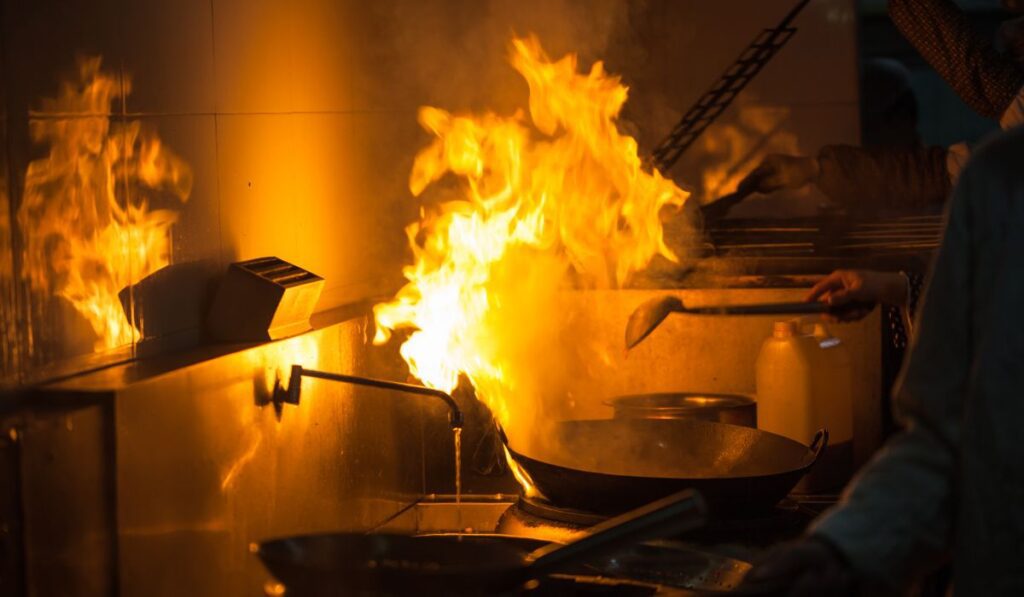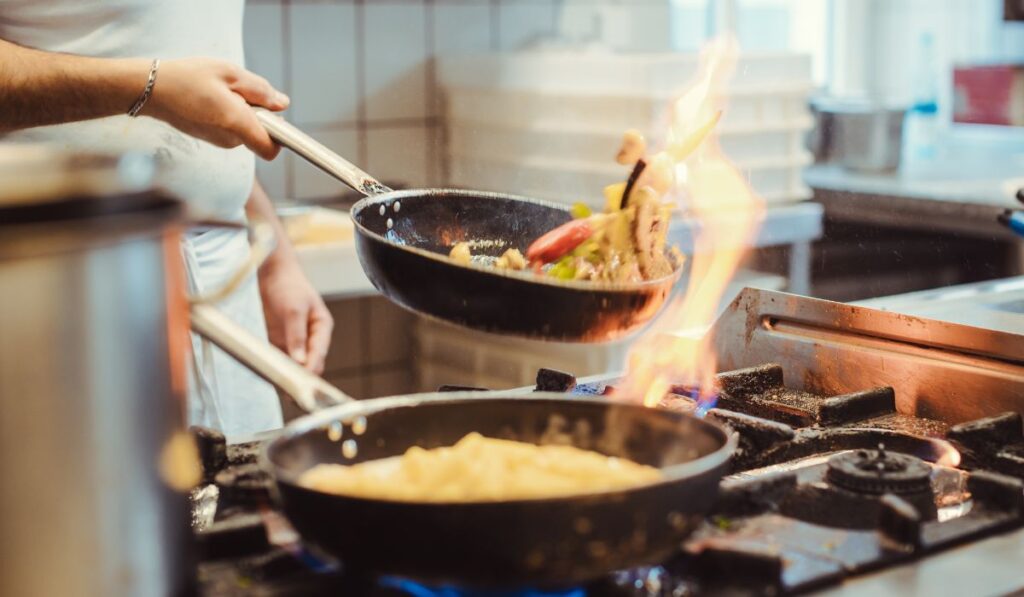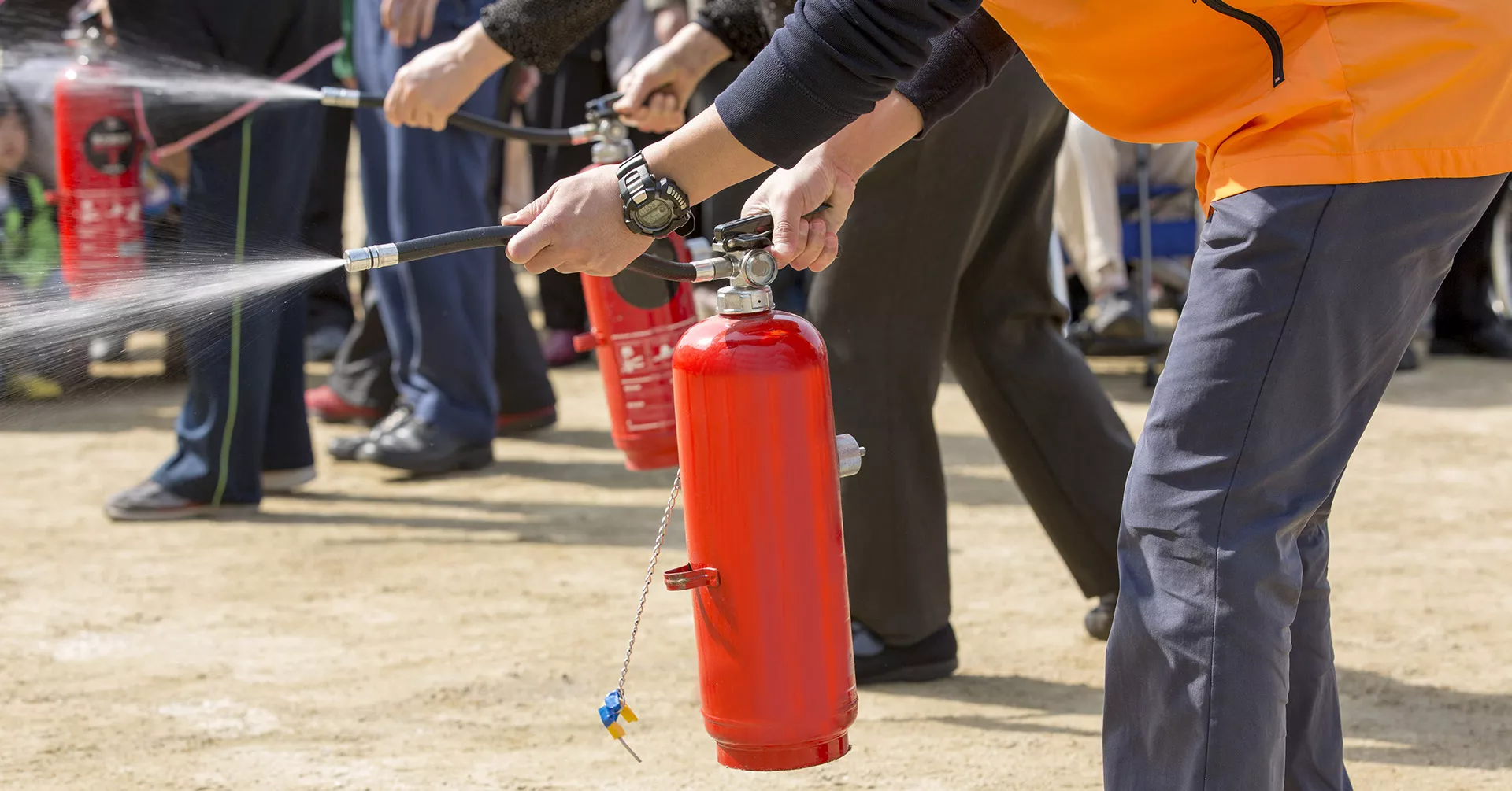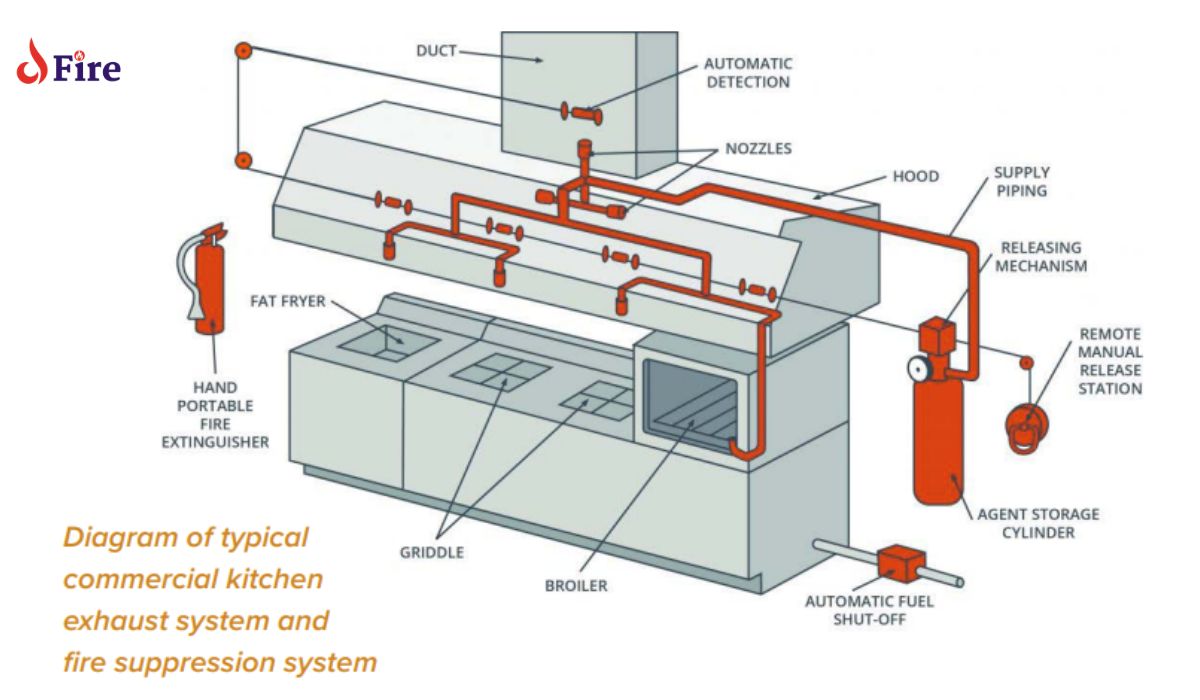A kitchen fire suppression system is a safety installation designed to extinguish fires in commercial kitchens. These systems detect heat, smoke, or flames, and dispense extinguishing agents automatically.
Commercial kitchens embody a high-risk environment for fires, due to the constant use of cooking oils, flammable liquids, and high-temperature equipment. This makes a robust fire suppression system essential for any food preparation business. Kitchen fire suppression systems are typically equipped with nozzles that are positioned above appliances and in ducts to target the suppression agent directly to the source of the fire.
They often use wet chemicals that not only quench the fire but also prevent re-ignition by creating a barrier between the heat source and the oxygen. Crucial for safety as well as compliance with fire codes, these systems can greatly reduce the risk of serious fire damage and ensure a safer working environment for kitchen staff. With regular maintenance and inspections, kitchen fire suppression systems remain a pivotal component in safeguarding lives and property in the culinary industry.
The Importance Of Kitchen Fire Suppression Systems
Kitchen fire suppression systems are crucial in any commercial cooking environment. They act like silent guardians, ready to tackle flames at a moment’s notice. Safety in the kitchen should never be an afterthought as the risks are high and the consequences severe.
Rising Statistics Of Kitchen Fires
Fires in commercial kitchens are not just common, they’re on the rise. Busy kitchens mean more heat, more oil, and higher chances of a fire. These systems become essential as they can swiftly extinguish flames, keeping everyone safe. Let’s look at some numbers crunching to understand why they’re so important:
- Over 60% of restaurant fires start in the kitchen.
- Unattended cooking is the leading factor in these fires.
- The damage goes beyond repairs, affecting lives and livelihoods.
Consequences Of Inadequate Fire Safety Measures
Ignoring the need for a robust fire suppression system can lead to dire outcomes. Without proper safety tools, a small flame can turn into an uncontrollable blaze within minutes. Here are the key impacts of inadequate fire safety measures:
| Consequence | Impact |
|---|---|
| Property Damage | Massive costs in repairs, replacements, and downtime. |
| Human Casualties | Potential for injury or loss of life. |
| Business Loss | Revenue drop, legal issues, and potential shutdown. |
Anatomy Of A Kitchen Fire Suppression System

Kitchens in commercial settings face the threat of fires sparked by high-heat cooking equipment and flammable oils. A Kitchen Fire Suppression System becomes a critical safety mechanism. Understanding its anatomy can save lives and property.
Key Components And Their Functions
The anatomy of a Kitchen Fire Suppression System is intricate, with several parts working in tandem for optimal fire protection. Its key components include:
- Control Panel: Brain of the system, monitors signals and triggers the response.
- Detectors: Senses heat and smoke, initiating the suppression process.
- Suppressant Delivery System: Pipes and nozzles that spray the extinguishing agent.
- Manual Pull Station: Enables users to activate the system by hand if needed.
- Tamper Switches: Alert staff if there’s interference with the system.
- Extinguishing Agents: Chemicals or mixtures that quell fires effectively.
- Gas Shut-off Valves: Cut off fuel sources to mitigate fire risks further.
How The System Activates In An Emergency
A Kitchen Fire Suppression System leaps into action through a series of swift reactions:
- Detectors sense extreme heat or smoke.
- The control panel receives a signal and initiates the extinguishing cycle.
- Suppressant is spread through the delivery system, covering the threatened area.
- If needed, the gas supply is severed by the shut-off valves to prevent more fuel for the fire.
- Alarms sound to warn individuals in the vicinity.
The system’s layered response ensures rapid suppression, minimizing damage and ensuring safety.
Types Of Kitchen Fire Suppression Systems

Kitchen fires can strike anytime, and being ready is not a choice but a necessity.
Different kitchens demand unique solutions. Choose a fire suppression system that best fits your space.
Wet Chemical Systems
Wet chemical systems fight fire with a special blend of liquid agents.
These agents extinguish fires quickly and cool the area to stop re-ignition.
- Specially designed for kitchens
- Effective on grease and cooking oils
- Prevents fire spread
Dry Chemical Systems
Dry chemical systems use powders to smother fires. They are good for spaces that see various types of fires.
| Types of Fire | Effectiveness |
|---|---|
| Grease | High |
| Electrical | Medium |
| Paper/Wood | Medium |
Hybrid Systems: The Best Of Both Worlds
Hybrid systems are an innovation, combining wet and dry methods.
They target the fire, douse it, and secure the area.
- Release wet agents to quench the fire
- Follow with a dry compound to prevent re-ignition
- Offer comprehensive protection

Credit: www.amazon.com
Installation Process Explained
The installation process of a kitchen fire suppression system is a critical step. It involves specific stages, detailed planning, and professional intervention. Understanding the complexity and importance of this process is essential for safety and compliance.
Site Assessment And Planning
Site assessment lays the groundwork for a secure installation. Professionals evaluate the kitchen layout during this phase. They focus on pinpointing potential fire hazards. These experts also determine the best locations for nozzles, sensors, and piping. A thorough plan emerges from this evaluation. It ensures the system covers all vital areas.
- Identify all cooking appliances and equipment.
- Measure the kitchen area for accurate system coverage.
- Choose appropriate suppression agents and delivery systems.
Professional Installation Vs. Diy
A kitchen fire suppression system requires technical expertise for installation. Professional installers bring knowledge and experience to the table. They ensure that the system meets all safety regulations.
DIY installations might appear cost-effective. But they pose significant risks. Mistakes can lead to system failures during emergencies. For a job this crucial, trust professionals.
| Criteria | Professional Installation | DIY Installation |
|---|---|---|
| Expertise | Highly skilled | Limited knowledge |
| Safety Compliance | Guaranteed adherence | Potential non-compliance |
| Risks | Minimized | Elevated |
| Insurance | May be affected positively | Could be compromised |
| Long-term Cost | Potentially lower | This could increase due to errors |
Meeting The Standards: Compliance And Certification
Ensuring your kitchen fire suppression system meets all required regulations is crucial for any commercial kitchen. It’s more than just an installation; it’s about compliance and peace of mind. Let’s delve into how you can guarantee that your system is up to code and certified to protect your kitchen, staff, and patrons from unforeseen fire disasters.
Local And National Fire Safety Regulations
Kitchen fire suppression systems must adhere to a range of safety standards. These vary from local building codes to national fire protection regulations. It is essential to know the rules in your area. For example:
- Local Fire Codes: Detail installation and maintenance requirements tailored to your community.
- National Standards: Such as NFPA 17A & NFPA 96 provide benchmarks for system performance and safety measures.
Regular inspections by fire authority representatives ensure these standards are not only met but continuously upheld. An up-to-date system is not a luxury, but a mandatory component of operating a kitchen within the law.
Certification Bodies And Approval Processes
Certification is the cornerstone of a legitimate kitchen fire suppression system. Various bodies provide certifications ensuring systems are reliable and effective:
- UL (Underwriter Laboratories): Offers rigorous testing and certification services to validate the system’s safety.
- FM (Factory Mutual): Provides worldwide industrial and commercial product certification and testing.
- ETL (Intertek Testing Services): Tests products against national and international safety standards.
The approval process involves multiple stages, from design analysis to live fire tests that replicate real-world scenarios. Upon passing these stages, systems receive a mark of safety that is recognized by authorities and insurance providers, ensuring your kitchen’s defense against fire is trusted and valid.
Regular Maintenance: The Key To Reliability
A kitchen fire suppression system is your first line of defense against disasters. To keep your kitchen safe, regular maintenance is a must. The system’s reliability heavily depends on consistent check-ups and swift issue resolution. An inadequately maintained fire suppression system might not function in an emergency. Hence, the need for a strict maintenance routine cannot be overstated. Let’s break down the essential tasks for keeping your system in top shape.
Routine Inspection Checklist
Regular inspections ensure your kitchen fire suppression system is always ready. Please check this list at least every six months:
- Check nozzles: Ensure they are not obstructed and aligned correctly.
- Inspect pressure gauges: Check if they read the proper pressure levels.
- Examine cylinders: Look for signs of damage or corrosion.
- Test alarms and detectors: Make sure they are functioning.
- Review actuation: Confirm manual and automatic activations work.
- Examine the discharge: Ensure no leaks or blockages exist.
Keeping a detailed log of each inspection can help track the system’s health over time.
Servicing And Troubleshooting Common Issues
Servicing your fire suppression system is crucial for uninterrupted safety. Address these common issues promptly:
- Accumulated grease: Clean the nozzles to prevent clogs.
- Worn seals or hoses: Replace any components showing wear and tear.
- Pressure variations: Refill or replace cylinders to maintain the correct pressure.
- Sensor malfunctions: Repair or replace faulty sensors immediately.
If you encounter a problem, seeking professional help is always the safest course of action.
Through routine checks and servicing, your kitchen fire suppression system remains a dependable guardian. Remember, preventive care is key to averting potential dangers in your kitchen.
The Role Of Training In Fire Suppression Readiness
The Role of Training in Fire Suppression Readness is vital for any kitchen environment. Fire emergencies require not only effective equipment but also a team that knows how to use it. Proper training ensures that staff can handle a fire suppression system efficiently. Let’s dive into how training can prepare a team for such critical situations.
Staff Training Seminars
Kitchens must hold regular staff training seminars. These seminars teach staff about fire risks and the use of suppression systems. A well-trained team can prevent small flames from becoming big problems. Key points covered in these seminars include:
- Understanding different types of fire extinguishers
- Operational instructions for suppression systems
- Identifying fire hazards specific to kitchens
- Maintenance and inspection routines for equipment
Fire Drill Practices And Evacuation Planning
Conducting fire drill practices is crucial. Drills train staff to act quickly and correctly during a fire. Evacuation planning is a part of these drills. It helps everyone know their role and escape routes. Practical exercises include:
- Simulated fire scenarios
- Evacuation route memorization
- Alarm system checks and usage
- Coordination with local fire services
Innovations In Fire Suppression Technology
Picture a bustling kitchen, where the sizzle of cooking turns to the roar of fire. This is where kitchen fire suppression systems play a lifesaving role. These systems have evolved. They now include cutting-edge technology designed to tackle fires with speed and smarts. Let’s explore the newest advancements that are setting the stage for safer kitchens everywhere.
Smart Detection And Ai Integration
Artificial Intelligence (AI) is at the forefront of fire safety. Smart detection tools can sense the slightest smoke or heat change. They act before flames grow. AI can learn cooking patterns.
- Quick response: Sensors detect heat and smoke in record time.
- Automatic alerts: Systems send warnings to connected devices.
- Data analysis: AI examines cooking trends to prevent false alarms.
These smart systems can tell the difference between a flaming pan and normal cooking. This reduces false alarms. It makes sure help is there when needed.
Futuristic Fire Suppression Solutions On The Horizon
Tomorrow’s kitchens will have even more advanced fire suppression. Companies are creating solutions that are not just reactive but proactive. Here are some future concepts in development:
| Technology | Description | Impact |
|---|---|---|
| Fire-fighting robots | Robots that can navigate kitchens and put out fires. | Reduce the need for human involvement. |
| Gel suppressants | Substances that cool and smother flames quickly. | Less damage and easy cleanup. |
| Sound wave extinguishers | Devices that use sound to disrupt fire. | Safe for use around food and people. |
These innovations will transform kitchen safety. They reduce risk and save lives. We eagerly await the day these technologies become commonplace.
Case Studies: Fire Suppression Systems In Action
Kitchen fire suppression systems play a critical role in maintaining safety. They act fast to prevent damage and save lives. We will explore real-life scenarios where these systems have either saved the day or taught us valuable lessons.
Success Stories: Averting Major Disasters
Restaurants and commercial kitchens have a high risk of fires. A well-installed fire suppression system can mean the difference between a scare and a catastrophe. Here are some instances where suppression systems have proven invaluable.
- A diner in Ohio: A grease fire began on a grill. The suppression system activated immediately. It extinguished the flames within seconds. Damages were minimal, and the diner resumed operations the following day.
- A food truck in California: During a busy lunch rush, a fire broke out. The truck’s fire suppression system triggered, dousing the flame. Thanks to this responsiveness, the food truck could continue serving dishes without major disruptions.
Learning From Past Mistakes
Not all stories have a happy ending. Some teach us crucial lessons. Here’s what we have learned from past fire suppression system failures.
| Location | Issue | Outcome |
|---|---|---|
| A New York Bistro | System did not activate due to poor maintenance. | Kitchen suffered extensive damage. It took weeks to repair and reopen. |
| A Fast Food Joint in Texas | Manual activation failed because of lack of training. | Employees panicked. The fire department had to step in, resulting in loss and downtime. |
These stories make it clear that regular maintenance and training are as important as the installation of the fire suppression system itself.

Credit: www.alertmedia.com
Investing In Safety: Cost Vs. Benefit Analysis
Picture a bustling kitchen with flames leaping from a sizzling pan. Suddenly, a small mistake turns into a blaze threatening everything around it. A kitchen fire suppression system becomes the hero in these critical situations. But what weighs more: the cost of installing such a system or the benefits it brings? Understanding the balance between spending and safety is key for any restaurant owner.
Upfront And Ongoing Costs Of Suppression Systems
Kitchen fire suppression systems may seem pricey at first glance. It’s important to explore all the expenses involved. The initial cost includes the purchase and installation of the system. Expect this figure to vary based on the size of your kitchen and the complexity of the system.
Ongoing costs might include:
- Regular inspections
- Maintenance fees
- Possible parts replacements
Let’s not forget about the potential costs associated with not having a system in place — the risk of expensive fires.
Long-term Savings And Peace Of Mind
Investing in a kitchen fire suppression system does come with its long-term savings.
These savings include:
| Cost Avoided | Benefit |
|---|---|
| Damage Repairs | Prevents extensive damage to equipment and property |
| Downtime | Keeps your kitchen operational after an incident |
| Insurance Premiums | Possibly lower rates with installed safety measures |
Beyond savings, safety for staff and guests should be a top priority. A reliable suppression system offers unmatched peace of mind, knowing your business has a safeguard against potential disasters. This level of security is invaluable.
Frequently Asked Questions On Kitchen Fire Suppression System
What Is A Kitchen Fire Suppression System?
A kitchen fire suppression system is a safety feature designed to detect and extinguish fires within commercial cooking areas automatically.
How Does Fire Suppression Work In Kitchens?
Fire suppression systems in kitchens typically use chemical agents to quickly smother flames and cut off the oxygen supply in case of a grease or electrical fire.
Can Kitchen Suppression Systems Be Automated?
Yes, kitchen fire suppression systems often include automatic activation features that engage when a fire is detected, without the need for human intervention.
Why Install A Fire Suppression System In Kitchens?
Installing a fire suppression system in a kitchen is crucial to prevent extensive damage, ensure compliance with safety codes, and protect lives during a fire outbreak.
What Maintenance Is Required For Suppression Systems?
Regular inspections and maintenance, typically semi-annually, are required to ensure kitchen fire suppression systems remain fully functional and compliant with fire safety regulations.
Are Kitchen Suppression Systems Expensive?
The cost varies depending on the size and complexity of the kitchen, but investing in a fire suppression system is essential for safety and can save money in the event of a fire.
Conclusion
Ensuring the safety of your kitchen demands consideration and proactive measures. A robust fire suppression system is more than a safety feature; it’s an investment in peace of mind. Remember, protecting your culinary space from fire hazards secures not just the heart of your home, but also guards lives and dreams.
Equip your kitchen with a dependable system today and cook with confidence tomorrow.

I’m Abdus Sobur, a highly skilled and professional Fire Safety Officer with a passion for safeguarding lives and property. Over the course of my career, I’ve conducted numerous successful fire safety audits, earning a reputation for excellence in ensuring public safety.
In addition to my role as a Fire Safety Officer, I’m also dedicated to raising awareness about the importance of fire safety. Through my blog, I share insights into the functions of different fire safety equipment, aiming to empower individuals with the knowledge they need to protect themselves and their communities.
I’m driven by a deep commitment to promoting fire safety awareness and preventing fire-related incidents.

